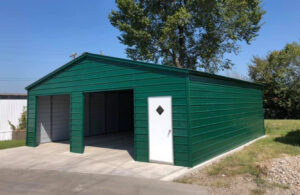
Metal buildings have earned a reputation for their exceptional durability and strength, making them a popular choice for various applications, from warehouses to residential structures.
When it comes to standing up to the elements, metal buildings excel in withstanding adverse weather conditions. Here’s why metal buildings are renowned for their sturdiness against the forces of nature.
Structural Strength
Metal buildings are engineered with high-quality steel, providing unmatched structural strength. Steel’s inherent properties, including tensile strength and durability, make metal buildings resilient against the forces of wind, snow, and other environmental stressors.
Wind Resistance
Metal buildings are designed to meet or exceed local building codes, ensuring they can withstand high wind speeds. The inherent strength of steel, combined with precise engineering, allows metal buildings to resist wind forces effectively, making them a reliable choice in areas prone to storms and hurricanes.
Snow Load Capacity
In regions with heavy snowfall, the load-bearing capacity of a structure is crucial. Metal buildings are engineered to handle significant snow loads. The inherent strength of steel framing prevents structural deformation under the weight of accumulated snow, ensuring the building remains sturdy and intact.
Resistance to Corrosion
Advances in protective coatings, such as galvanization and other corrosion-resistant finishes, contribute to the longevity of metal buildings. These coatings shield the steel from rust and deterioration, preserving the structural integrity of the building even in humid or coastal environments.
Fire Resistance
Contrary to common misconceptions, steel is inherently non-combustible. Metal buildings have a high level of fire resistance, providing a secure and durable structure that can better withstand fire incidents compared to traditional building materials.
Durability in Seismic Zones
Metal buildings demonstrate resilience in seismic zones due to steel’s flexibility. Steel framing can absorb and dissipate seismic forces, minimizing the risk of structural damage during an earthquake. This flexibility contributes to the overall stability of metal buildings in areas prone to seismic activity.
Minimal Maintenance Requirements
Metal buildings are known for their low maintenance needs. The durable nature of steel, coupled with protective coatings, reduces the likelihood of decay, warping, or degradation over time. This results in a structure that maintains its sturdiness with minimal upkeep.
Conclusion
The sturdiness of metal buildings against the elements is a testament to the exceptional qualities of steel as a construction material. From resisting wind and snow loads to demonstrating resilience in seismic zones, metal buildings stand as robust structures that reliably weather the challenges posed by nature.
